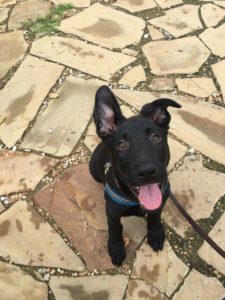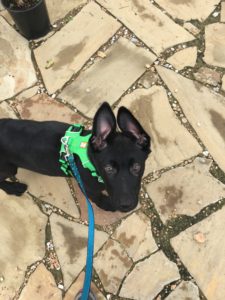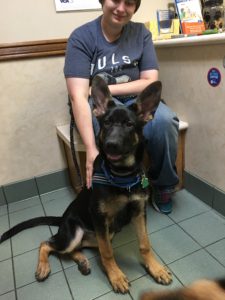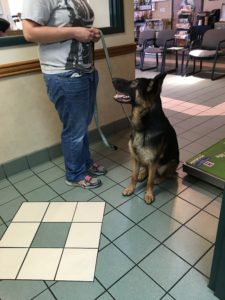A Bridge Over Changing Water: Easy Transitions Part 5
Like “a bridge over troubled waters” bridge behaviors help puppies find confidence through communication with their new family, and in a new environment.
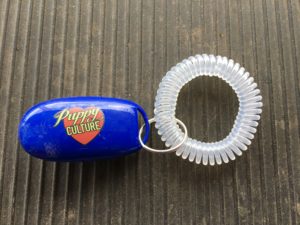
Unlike a verbal marker which can sound different from person to person, a clicker sounds the same no matter who clicks it.
Using the beauty of operant conditioning to create confidence and adaptability to transitions.
I’ve saved the most important for last because it’s really just THAT important.
What is a bridge? For our purposes here, a bridge is a behavior taught in such a way that a positive emotional response is PART of the behavior. A bridge doesn’t work if it’s a behavior the puppy learned through fear or distress, we want our bridges to help us reach our goal of a dog who thrives under stress, and who enjoys life’s transitions. Since the emotion the puppy experiences when it learns a behavior becomes attached to that behavior, we do not want any unpleasant emotion to travel on our bridge.

Learning to sit on a platform, the happy anticipation this puppy feels learning this behavior will be forever attached, she’ll feel happy when cued to sit later in her new home.
The magic of the bridge is in the communication between the puppy and the new owner. When puppies leave our home they also leave behind all those contextual cues that help them know what is expected when, and what behavior might be expected of them in particular settings. All those nice clear paths to reinforcement are obscured. They feel a bit like “strangers in a strange land” in the new home.
The new family often feels the same way, just how do they get the puppy to do the things they need?
Our bridge behaviors give the puppy a way to communicate to the owner and the owner to the puppy. There is empowerment and confidence in this shared language.
We encourage our new families to start the day they bring their puppy home with the Puppy Culture Communication Trinity, and to run through these lessons in order. Running through these familiar lessons helps the puppy feel confident and competent in the new home from day 1.
So our bridge behavior MUST include a positive emotional response, since we are Puppy Culture breeders and clicker trainers this is easy for us, as all our Puppy Culture Active Enrichment Behaviors and our other clicker trained behaviors fit this requirement.
Here are the bridge behaviors our puppies are taught before they go home.
1. Sit (Mand) for things you want.
2. Attention.
3. Follow Leash Pressure.
4. Hand Target (touch your nose to my hand).
With this small set of baby behaviors our puppy can, when unsure what to do, be quickly and easily Clicked and Treated for any one of these behaviors. All of these behaviors are very useful for our new families too.
Of course, we also need to teach our new families the basics of clicker training, and most importantly when and how to use the bridge behaviors. Much of this is covered in the Puppy Culture film that we provide to each family before their puppy goes home with them.
Here are some examples of using bridge behaviors during transition week.
First Day:
Puppy can Mand to leave crate.
Puppy can Mand for meals.
Puppy can have the clicker powered up.
Puppy can Mand for toy toss.
Puppy can give attention for tugging.
Puppy can Mand for petting.
Second Day:
Puppy can Mand to leave Crate.
Puppy can Mand for meals.
Puppy can play The Box Game.
Puppy can practice Leash Walking.
Puppy can Mand for petting.
Puppy can give Attention for toy toss.
At Vet:
Puppy can Mand for social interaction.
Puppy can play Attention while vet listens to heart.
Puppy can follow a Hand Target onto scale.
Attention is a powerful bridge behavior!
Because we have already conditioned these bridge behaviors, AND taught the puppy owner how to teach, use, and reinforce them, the puppy can experience these situations (all of which are transitions) as fun and reinforcing events because the puppy “knows” how to earn reinforcement in the form of praise, food, and play.
This helps our puppy learn from the very start that it has control over what happens to it, that good things are plentiful and easy to access, and that change predicts these wonderful things.
Puppies who are unsure can express a variety of behaviors that we don’t want the puppy to learn or practice. Puppies can be frantic, hectic, nervous, avoidant, and a laundry list of other emotional states and behaviors best never learned.
With a small set of bridge behaviors our new puppy owner can ask for desirable behaviors, and our puppy can respond quickly and happily, finding a desirable path to reinforcement that serves it well throughout life.


